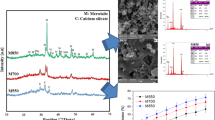Abstract
In the present study, mesoporous calcium–magnesium–silicate was prepared via cetyltrimethylammonium bromide (CTAB)-assisted sol–gel method in both acidic and alkaline mediums. The effects of synthesis medium on structural properties, and drug delivery behavior of mesoporous calcium–magnesium–silicate by using ibuprofen as model drug are investigated. The X-ray diffraction results of the samples calcined at 600 °C showed that the sample synthesized at alkaline environment is composed of CaSiO3 and CaMgSiO4 phases, whereas in acidic condition the sample consists of akermanite, CaMgSiO4, CaSiO3, and MgO. The specific surface area of the mesoporous calcium–magnesium–silicate samples prepared in acidic and alkaline conditions were 220 and 140 m2/g, respectively. The mesoporous calcium–magnesium–silicate sample synthesized in the acidic condition resulted in smaller particles with a size ranging between 50 and 100 nm. Encapsulation of ibuprofen into mesoporous calcium–magnesium–silicate was studied as a function of time.
Graphical Abstract







Similar content being viewed by others
References
Arcos D, Vallet-Regi M (2013) Bioceramics for drug delivery. Acta Mater 61:890–911
Vallet-Regi M (2014) Bio-ceramics with clinical applications. Wiley Hoboken, pp 343–359
Mourino V, Boccaccini AR (2010) Bone tissue engineering therapeutics: controlled drug delivery in three-dimensional scaffolds. J R Soc Interface 7:209–227
Vallet-Regi M, Balas F, Colilla M, Manzano M (2008) Bone-regenerative bioceramic implants with drug and protein controlled delivery capability. Prog Solid State Chem 36:163–191
Wang XP, Li X, Lto A, Sogo Y (2011) Synthesis and characterization of hierarchically macroporous and mesoporous CaO–MO–SiO2–P2O5 (M = Mg, Zn, Sr) bioactive glass scaffolds. Acta Biomater 7:3638–3644
Wu CT, Ramaswamy Y, Zreiqat H (2010) Porous diopside (CaMgSi2O6) scaffold: a promising bioactive material for bone tissue engineering. Acta Biomater 6:2237–2245
Huang Y, Jin X, Zhang X, Sun H, Tu J, Tang T, Chang J, Dai K (2009) In vitro and in vivo evaluation of akermanite bioceramics for bone regenerationʼ. Biomaterials 30:5041–5048
Huo Q, Margolese DI, Ciesla U et al (1994) Generalized syntheses of periodic surfactant/inorganic composite materialsʼ. Nature 368:317
Tanev PT, Pinnavaia TJ (1995) Biomimetic templating of porous lamellar silicas by vesicular surfactant assemblies. Science 267:865
Huo Q, Margolese DI, Ciesla U, Stucky GD et al (1994) Organization of organic molecules with inorganic molecular species into nanocomposite biphase arrays. Chem Mater 6:1176
Schubert U, Husing N (2005) Synthesis of inorganic materials. Wiley-VCH Weinheim, Germany. pp 192–221
Stolarski M, Walendziewski J, Steininger M, Pniak B (1999) Synthesis and characteristic of silica aerogels. Appl Catal A 177:139–148
Hassanzadeh-Tabrizi SA, Bigham A, Rafienia M (2016) Surfactant-assisted sol–gel synthesis of forsterite nanoparticles as a novel drug delivery system. Mater Sci Eng C 58:737–741
Tavakoli H, Sarraf-Mamoory R, Zarei AR (2015) Solvothermal synthesis of copper nanoparticles loaded on multi-wall carbon nanotubes as catalyst for thermal decomposition of ammonium perchlorate. J Adv Mater Process 3:3–10
Foroughi F, Hassanzadeh-Tabrizi SA, Bigham A (2016) In situ microemulsion synthesis of hydroxyapatite-MgFe2O4 nanocomposite as a magnetic drug delivery system. Mater Sci Eng C 68:774–779
Bigham A, Hassanzadeh-Tabrizi SA, Rafienia M, Salehi H (2016) Ordered mesoporous magnesium silicate with uniform nanochannels as a drug delivery system: The effect of calcination temperature on drug delivery rate. Ceram Int 42:17185–17191
Izquierdo-Barba I, Colilla M, Manzano M, Vallet-Regi M (2010) In vitro stability of SBA-15 under physiological conditions. Microporous Mesoporous Mater 132:442–452
Choudhary R, Koppala S, Swamiappan S (2015) Bioactivity studies of calcium magnesium silicate prepared from eggshell waste by sol–gel combustion synthesis. J Asian Ceram Soc 3:173–177
Zhao D, Wan Y, Zhou W (2013) Ordered mesoporous materials. Wiley, Hoboken, p 140
Sing KSW, Everett DH, Haul RAW, Moscou L, Pierotti RA, Rouquerol J, Siemieniewska T (2005) Reporting physisorption data for gas/solid systems with special reference to the determination of surface area and porosity. Pure Appl Chem 57:603–619
Sinko K (2010) Influence of chemical conditions on the nanoporous structure of silicate aerogels. Materials 3:704–740
Lin H, Mou C (2002) Structural and morphological control of cationic surfactant-templated mesoporous silica. Acc Chem Res 35:927–935
Manzano M, Aina V, Arean CO, Balas F, Cauda V, Colilla M, Delgado MR, Vallet-Regi M (2008) Studies on MCM-41 mesoporous silica for drug delivery: effect of particle morphology and amine functionalization. Chem Eng J 137:30–37
Gao L, Sun J, Zhang L, Wang J, Ren B (2012) Influence of different structured channels of mesoporous silicate on the controlled ibuprofen delivery. Mater Chem Phys 135:786–797
Shen S, Chow PS, Chen F, Tan RB (2007) Submicron particles of SBA-15 modified with MgO as carriers for controlled drug deliver. Chem Pharm Bull 55:985–991
Wu J, Zhu YJ, Cao SW, Chen F (2010) Hierachically nanostructured mesoporous spheres of calcium silicate hydrate: surfactant-free sonochemical synthesis and drug-delivery system with ultra high drug-loading capacity. Adv Mater 22:749–753
Horcajada P, Ramila A, Perez-Pariente J, Vallet-Regi M (2004) Influence of pore size of MCM-41 matrices on drug delivery rate. Microporous Mesoporous Mater 68:105–109
Balas F, Manzano M, Horcajada P, Vallet-Regi M (2006) Confinement and controlled release of bisphosphonates on ordered mesoporous silica-based materials. J Am Chem Soc 128:8116–8117
Author information
Authors and Affiliations
Corresponding author
Ethics declarations
Conflict of interest
The authors declare that they have no competing interests.
Rights and permissions
About this article
Cite this article
Ghadiri, S., Hassanzadeh-Tabrizi, S.A. & Bigham, A. The effect of synthesis medium on structure and drug delivery behavior of CTAB-assisted sol–gel derived nanoporous calcium–magnesium–silicate. J Sol-Gel Sci Technol 83, 229–236 (2017). https://doi.org/10.1007/s10971-017-4404-1
Received:
Accepted:
Published:
Issue Date:
DOI: https://doi.org/10.1007/s10971-017-4404-1




